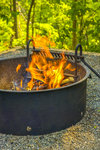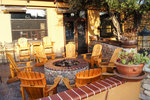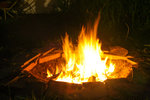


Fire pits are one of the most coveted summer items. Why? They add ambiance to a cool evening, not to mention they’re perfect for social gatherings. The best part though is that you can get one for yourself for a lot less than you probably think.
A fire pit has always been a popular patio addition, but today they are the top requested design feature, according to the American Society of Landscape Architects.
“They’re turning into a primary thing to go with new houses,” said Peter Gecho, owner of Gecho Construction.
There are so many styles, sizes and materials out there that make the choices tough. In the end, it should all be based on your space at hand and budget.
Here are some of the important things to consider as you’re getting started:
Usually around $100 is what you’ll be looking at if you keep it simple. Just remember, sometimes simple is best. To keep the cost at that level, you should buy your own stones to form the wall, and dig the hole yourself. Typically, a plain unit can also be purchased for that amount at a large retail establishment.
The fancier you go from there, the higher prices will rise. Common bonus features include seating, added lighting, lifted surfaces and more.
One of the best things you can add is a covered roof.
“With a cover you can enjoy it even in climate, like when it’s raining,” Gecho said.
There’s two types of fire pits — those that are permanently made part of the ground and those that are portable. Both have benefits.
A couple of questions you’ll need to ask yourself include, do you want a fire pit that is built in and a focal point in the yard, or something that’s lightweight and could be taken anywhere you want?
If built-in is the preference then it’s best to match the design with materials from the house or lawn for continuity. A lot of parts can be bought at a store and assembled at the site. Doing the project this way allows for a lot more creativity and outside the box thinking.
Sometimes, however, you spot your creative idea sitting on a shelf. These are the portable options and they come in all shape and sizes. Many feature a simple copper pit bowl that will burn wood. What makes them most ideal is that they are great for camping or beach parties, or anything else fun that is happening outside of your backyard.
Wood is traditional, but that doesn’t mean it’s defaultly the best option in every scenario. Gas and propane are the two most frequently used alternatives. Using them instead of wood saves you the hassle of collecting the wood and keeping the fire going when it’s in use.
“Gas is easier to light and there’s no mess afterward,” Gecho said. “Wood smoke has to be vented, but it has benefits, too.”
Those benefits are that only real logs give you the true outdoor smell and crackle.
Whichever way you lean, both methods of burning can be installed to a built-in pit or a portable.
Natural surfaces such as concrete, stone, gravel or any other fire-resistant composite is best to put the structure on. A wood deck can be very dangerous as embres can sometimes fly out.
In general, fire pits can really go anywhere you want because they’re very versatile to fit the vision of the décor. They are small enough to function as a focal point, yet versatile enough to match any surrounding. In short, you can set them up to serve a variety of roles.
The possibilities are endless, but no matter how you go about setting one up, make sure you always remember that you’re dealing with fire.
Keep in mind the following safety tips as you take on and enjoy your finished project: